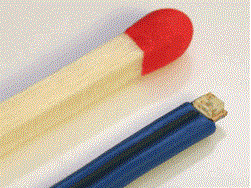Identifying different types of LEDs & LED boards-2

Red, green, blue (RGB) LED boards
RGB LED boards include red, green, and blue emitters, which allow for it to combine the three primary colors in different amounts to produce new colors with incredible precision. There are literally millions of possibilities of color combinations with today’s increasingly sophisticated controllers.
Most RGB LEDs use a 4-pin connection with a common lead (anode or cathode), which is the longest connection (others have just two leads and include a built-in electronic control unit). Since the light requires electronic circuits to control the blending and diffusion of different controls, RGB LEDs offer users tremendous control of color emission. As a result, they’re used a wide variety of applications, including light shows, video display, accent lighting, status indicators, and more.
Alphanumeric
The alphanumeric LED boards light has fallen in popularity in recent years. While some point to the cancellation of the television show24, the decline is actually due in large part to the increased sophistication of LCDs, which offer greater visual flexibility and much less power consumption. Regardless, they’re still worth covering.
As the image goes to show, there are four subtypes of the alphanumeric display. The 7-segment handles all numbers and only a limited set of letters; 14- and 16-segment displays are referred to as the "starburst” displays: They can cover the full 26-character Roman alphabet in upper case as well as numerals 0-9. You’ll note that the only difference between the two is a break on the top and bottom bars on the 16-segment digit. This is done to improve the look of some characters. Last is the matrix which is, obviously, the most versatile of the four. It covers the full alphabet (both in upper case and lower case), all numbers and a full variety of symbols.
Lighting LEDs
Lighting LEDs (also referred to as LED lamps, LED bars, or illuminators) come in many different shapes and sizes, including the popular Edison light bulb design. As mentioned throughout this article, heat is the enemy of an LED. An example of ways in which manufacturers are addressing this issue with these more commonly used LEDs is they incorporate an aluminum/ceramic body with fins to increase the total area for heat to escape.
Heat dissipation methods vary based on manufacturer and how the light will be used. As new solutions are discovered though, this particular category of LEDs will continue to expand. It’s certainly worth watching over the next few years.
So there you have it: one light, plenty of options
Latest Articles
- Familiar with a variety of LED modules
- The LED display
- Times Square’s Biggest and Most Expensive Digital Billboard Is Set to Shine
- Identifying different types of LEDs & LED boards-2
- Identifying different types of LEDs
- What is the full-color digital tube
- Training Tips full color modules
- what is SCROLLING BOARD Module
- Training on components of scRolling/ribbon/caption led board
- Controller board of SCROLLING BOARD


